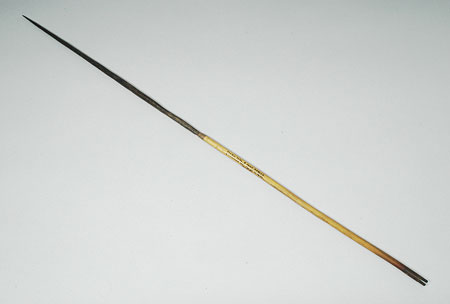Accession Number:
1930.86.19 .1
Country:
Sudan
Cultural Group:
Moru
Date Made:
By 1930
Materials:
Wood Plant , Plant Fibre , Resin Plant? , Pigment?
Process:
Carved , Decorated , Incised , Notched , Bound , Socketed
Dimensions:
Total L = 795; arrowhead L = 395, diam = 9; shaft L = 400, diam = 9, nock L = 10, upper binding L = 11, lower binding L = 22 mm [RTS 23/5/2005].
Weight:
32.3 g
Local Name:
atu?
Other Owners:
Edward Evan Evans-Pritchard
Field Collector:
Edward Evan Evans-Pritchard
PRM Source:
Edward Evan Evans-Pritchard
Acquired:
Purchased 31 December 1930
Collected Date:
By 1930
Description:
Arrow consisting of a narrow elongated arrowhead carved from a single piece of dark brown wood (Pantone black 4C), with shaving marks down the sides.
This has a pointed tip with a gradually expanding body that varies from round to slightly oval in section.
It has been decorated with incised lines running around its base, consisting of 2 oblique lines, a chevron, then a third oblique line facing the opposite direction, with 2 parallel lines around the circumference below.
The base of the arrowhead then tapers inwards, to allow it to be force fitted into the socketed top of the shaft.
This has been carved from a length of light yellow wood (Pantone 7509C), and is circular in section.
It has a straight body with a smoothed surface, and has been bound round with fine plant fibre immediately below the junction with the point, and again just above the butt, which has been nocked, with two rectangular notches cut in opposite sides.
This area has been discoloured a darker reddish brown, perhaps through the addition of some kind of material to fix the binding in place, perhaps resinous; the nocked end is also discoloured black.
It is complete and intact.
The arrow has a weight of 32.3 grams, and a total length of 795 mm; the visible area of the arrowhead is 395 mm long and has a diameter of 9 mm; the shaft is 400 mm long and has a body diameter of 9 mm, and a notch length of 10 mm; the upper binding is 11 mm long and the lower binding is 22 mm long.
This object was collected by Edward Evan Evans-Pritchard in the Southern Sudan sometime before December 1930, as part of a group of 12 arrows; for the other examples, which all have iron arrowheads, see 1930.86.19.2-12. Other arrows in this group, such as 1930.86.19.3, have a more obvious red staining over the bound areas. Powell-Cotton also collected a number of Moru archer's items, including a bow ( kusu ), iron-headed arrow (atu) and hide ring for drawing back the bow string ( driba ) - see 1934.8.33-35.
Rachael Sparks 29/8/2005.
This object was collected by Edward Evan Evans-Pritchard in the Southern Sudan sometime before December 1930, as part of a group of 12 arrows; for the other examples, which all have iron arrowheads, see 1930.86.19.2-12. Other arrows in this group, such as 1930.86.19.3, have a more obvious red staining over the bound areas. Powell-Cotton also collected a number of Moru archer's items, including a bow ( kusu ), iron-headed arrow (atu) and hide ring for drawing back the bow string ( driba ) - see 1934.8.33-35.
Rachael Sparks 29/8/2005.
Primary Documentation:
Accession Book Entry
[BIV, p.
138] - 1930 [insert] 86 [end insert]
E.E.
EVANS PRITCHARD
31 Dec.
Specimens collected by himself in the EASTERN SUDAN, etc.
[insert] 19 [end insert] - 1 wooden-pointed & 11 iron-headed arrows [listed separately], ib[idem] [MORO tribe].
[Base of p.
139, total of items 1930.86.1-65] - P[ai]d by cheque 31 Dec £
25-0-0
.
Added Accession Book Entry [p. opposite 138] - 1930.86 See Related Documents File for letter from Henry Balfour to Evans-Pritchard concerning the purchase of this collection.
Card Catalogue Entry - There is no further information on the tribes or object catalogue cards [RTS 2/6/2004].
Related Documents File - This contains a letter from Balfour to Evans-Pritchard, dated 31 December 1930 that specifies the objects which he would like to purchase for the Pitt Rivers Museum, and suggests a price of £25, which was one quarter of his annual budget. The list matches the objects ultimately accessioned quite closely. This item is part of a group mentioned as "Arrows (Moro)" [RTS 17/5/2004].
Pitt Rivers Museum label - AFRICA, SUDAN, Moru tribe. Arrow with wooden point. Purchased E.E. Evans-Pritchard 31 Dec. 1930. 1930.86.19.1 [plastic coated label, tied to object; RTS 23/5/2005].
Written on object - MORO Tribe, E. CENT. AFRICA. E. Pritchard coll. - Pur. 31.12.1930 [RTS 23/5/2005].
Added Accession Book Entry [p. opposite 138] - 1930.86 See Related Documents File for letter from Henry Balfour to Evans-Pritchard concerning the purchase of this collection.
Card Catalogue Entry - There is no further information on the tribes or object catalogue cards [RTS 2/6/2004].
Related Documents File - This contains a letter from Balfour to Evans-Pritchard, dated 31 December 1930 that specifies the objects which he would like to purchase for the Pitt Rivers Museum, and suggests a price of £25, which was one quarter of his annual budget. The list matches the objects ultimately accessioned quite closely. This item is part of a group mentioned as "Arrows (Moro)" [RTS 17/5/2004].
Pitt Rivers Museum label - AFRICA, SUDAN, Moru tribe. Arrow with wooden point. Purchased E.E. Evans-Pritchard 31 Dec. 1930. 1930.86.19.1 [plastic coated label, tied to object; RTS 23/5/2005].
Written on object - MORO Tribe, E. CENT. AFRICA. E. Pritchard coll. - Pur. 31.12.1930 [RTS 23/5/2005].




